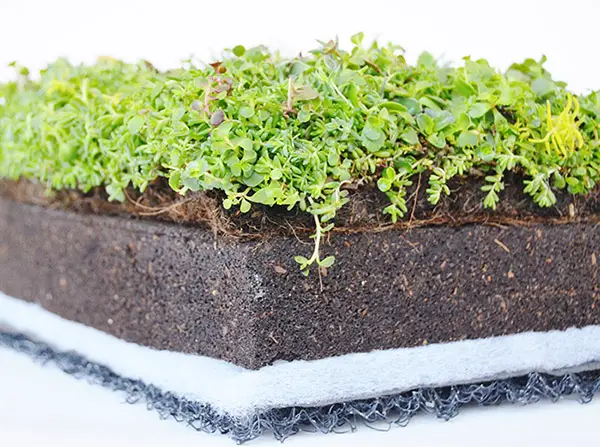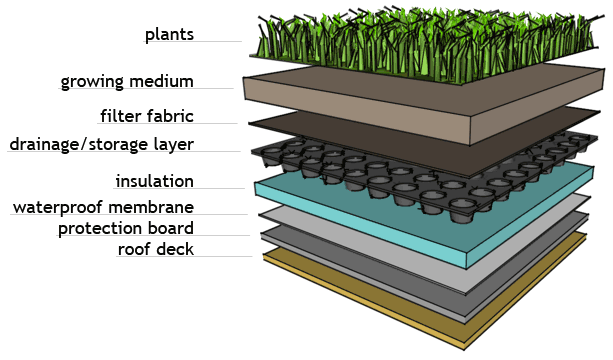Rooftop garden construction. Roof gardens are a little bit different from green roofs in the sense that roof gardens are generally created for entertainment and recreational activities and to create an outdoor living space for people living in the building.
Contents
Green roofs are usually created for economic and environmental benefits and cover the whole roof area. Green roofs tend to improve insulation and energy efficiency by reducing heating and cooling costs.
Here we provide some roof garden construction details that can help you.
While constructing your roof garden, you need to consider the two main applications, which are:
- Waterproofing
- Garden assembly
Both these applications need to be installed with the implementation of proper design and accurate techniques. This is because the roof garden will be beneficial only if it does not damage your building.
This is possible by implementing proper waterproofing techniques. Also, the garden will last longer if the assembly is done in an appropriate way.

Waterproofing application
The waterproof membrane is used primarily at the bottom (or you can say that the first layer that comes after the roof floor is this membrane).
The membrane can be used in an inverted or protected way. Research has found that inverted membranes are more suitable than protected ones because of their durability. The three main elements of waterproofing are:
- The added weight (soil and water) should support the building. The structure of the building and the rooftop garden should be compatible with one another.
- There should be proper integration between the system and the waterproofing membrane.
- The roof drains should be of proper size and placed in appropriate locations.

Considerations for the membrane
Waterproof membranes take a lot of time and involve much cost for their repair. Therefore, it is not recommended that you use a membrane system that lasts for 15 to 20 years.
There are a number of factors that can damage a waterproof membrane, like root penetration, gardening tools that cause mechanical damage, etc. Therefore, the membrane system should be durable and long-lasting.
It would be a better idea to consider and use membranes that have been successful in previously installed applications.
There is a common misunderstanding that waterproofing components in roofs and ground structures are the same. Actually, there are some materials that are suitable for both structures, but not all materials suit both.
These components and materials are selected according to their waterproofing capability. The material of the roof membrane remains in direct contact with weathering elements, including wind, sun, rain, ice, snow, etc.
Usually the life of roof materials is 10 to 20 years; this can be increased with the implementation of remedial strategies.
On the other hand, the waterproofing components of ground-level systems are exposed to water buildup and soil instead of various weathering conditions.
Constructing the waterproof membrane
The membrane required for roof garden construction should have the following characteristics:
- Resistance to ultraviolet rays and root penetration.
- The capability to have a long lifespan without deterioration.
- The capability to withstand weather like extreme temperatures and other atmospheric conditions.
- Durable and strong enough to withstand the attacks of microorganisms, insects and various soil chemicals.
- The inability to be damaged if submerged in water. This means that the membrane should resist wet conditions for long periods of time.
- The most important characteristic is that it should be flexible enough for proper installation, as there are many intersections and construction joints on a roof.
Applying the protection board
The protection board is placed above the waterproofing membrane. The main purpose of the protection board is to protect the membrane from the mechanical equipment and other tools that are used to construct the garden.
Therefore, the protection board should be hard and durable so that it can protect the membrane efficiently. After the installation of the garden, there is no need to remove the protection board.
Installing the insulation layer
Insulation is used primarily for meeting the requirements of r-value. The thermal resistance of a material achieved at a particular thickness is known as the r-value.
Due to the thermal properties provided by insulation, the heating and cooling costs are reduced to a great extent. In winter, this insulation doesn’t let heat escape from the house, while in summer it prevents the heat from entering the house.
A number of components are then installed above the insulation layer, like saturated soils, concrete, toppings, etc. Therefore, it must be ensured that the insulation layer is durable enough to withstand the weight of these components.
Garden assembly
The membranes are done. Now you have to install the garden. This involves the following components:
- Drainage layer
A proper drainage system is required for the accurate installation of the green garden. It should be capable of collecting water from the building and from the interior drain of the roof.
A perfect roof drainage system will prevent water blockage and will efficiently eliminate extra water from the system.
- Filter fabric
A filter fabric is installed to ensure that only water or moisture is drained through the drainage system. It prevents plant debris or soil loss through running water, which otherwise can block the drains. It also has a hand in keeping the soil and other planting medium in place.
- The planting medium
Rooftop garden construction incorporates many forms of soil composition as a planting medium. The type of soil and depth should be selected based on the type of roof garden you are going to install.
Once you have set up these components, the medium is ready for growing plants. With the help of the above rooftop garden construction details, you can install a roof garden perfectly.
If you have any questions, refer to the roof garden construction detail drawings.
Hi, I’m Jim. I was a roofing constructor for 20 years, before deciding to start myrooff.com and gather the best content about roofing. I love woodworking and construction and it was only natural for me to start this passion project of mine. Thank you for visitng.

